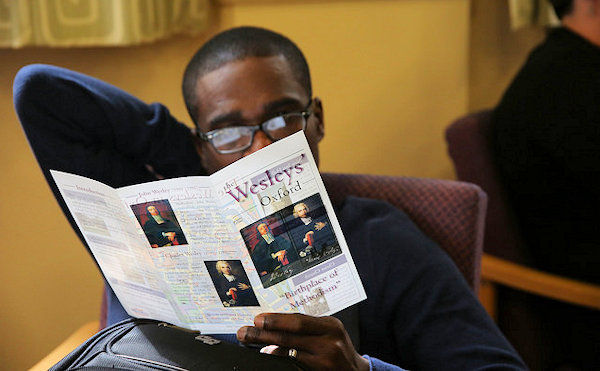The Oxford Holy Club is the scene of this 1st of 3 part series on making disciples the Wesley way.
JOE IOVINO
United Methodist Communications
As in other areas of life, being part of a group helps us grow as disciples of Jesus Christ.
Many achieve fitness goals through participation in a weight loss or exercise group. Writers and artists join collectives where they regularly comment on one another’s work. Others become better moms and dads as part of a parenting group.
Sharing with those who celebrate our victories, support us through struggles, and share tips they have learned along the way, increases our chances of improvement.
During the Wesley Pilgrimage in England, participants learn about the rich history of disciple-making and disciple-shaping groups in The United Methodist Church.
Where it all began
Pilgrims travel to where it all began, Christ Church in Oxford, the alma mater of John and Charles Wesley.
When John Wesley was a student at Christ Church (no one calls it Christ Church College), he longed for a group with whom he could share his spiritual growth. As a student, he never quite found what he was looking for.
When his brother Charles arrived in Oxford to study at Christ Church, John may have hoped that being in the same town would give them opportunity to support one another in their discipleship. Their mom Susanna had instilled in her children a routine of spiritual accountability from an early age.
Unfortunately, that didn’t quite work. Charles fell into a routine similar to other college students, putting his spiritual growth on hold.
John, now studying to become ordained a priest in the Church of England, was elected a fellow at Lincoln College, a smaller college in Oxford. As a fellow, Wesley was guaranteed a room, meals, students to teach, and an annual stipend for life, as long as he remained unmarried.
Wesley pilgrims walk the several blocks between the two schools. Lincoln College is proud of its association with this 18th century fellow. There is a bust of John Wesley on an exterior wall and a room decorated in the style of Wesley’s study. Etched into the glass of the chapel entrance doors are the words, “John Wesley, Fellow, 1726-51.”
At the request of his father, the Rev. Samuel Wesley, rector (lead pastor) of St. Andrew’s Church in Epworth, John went home to serve as the curate (associate pastor) in the congregation in which he and his brothers and sisters were raised.
One day, John received a letter from Charles. “I … awoke out of my lethargy,” his younger brother wrote of his renewed desire to focus on his spiritual growth. He also asked for tips on keeping a spiritual journal, a practice John found helpful.
Growing as disciples together
John soon traveled to Oxford to visit his brother. A few weeks after his arrival back in Epworth, Lincoln College asked him to return to his residence on campus and resume his duties as a fellow.
Reunited in Oxford, the brothers periodically met with Charles’ friend William Morgan for prayer, Bible study, and conversation. They also received the Lord’s Supper at least once a week, earning them the nickname “Sacramentarians.”
Slowly, more Oxford students joined the group.
Morgan invited fellow members to join him in visiting the Castle prison on the outskirts of town. After their first visit, John and Charles vowed to return at least weekly to visit the debtors and felons incarcerated there.
The Castle prison still stands today, but is no longer used a prison. Part of the prison has been renovated into a luxury hotel and restaurant. Historic tours are offered in restored sections of the building.
Later, Morgan suggested the group also join him in other ministries with which he was involved. Soon these young Oxford men were teaching children, visiting the elderly, and caring for the poor as part of their regular activities.
Living the name
Other students noticed them, but didn’t understand their zeal. They gave the group mocking nicknames including, Bible-moths, The Holy Club, Supererogation-Men, and Methodists. Undeterred, they continued their meetings and ministries.
The Holy Club, as this group is most often referred to as today, was adopting a holistic approach to their Christian formation. They studied the Bible, prayed, and worshiped together. They also served together, reaching out to those in their community who were in the most need.
The Methodist movement was, in a sense, a replication of this group to help others grow as leaders in discipleship for the church.
The focus on both love of God and neighbor expressed in everyday actions, was a centerpiece of early Methodism, and continues today.
~Learn how the Holy Club grew into the Methodist movement in Part 2, coming next week.
Last Updated on December 28, 2022

